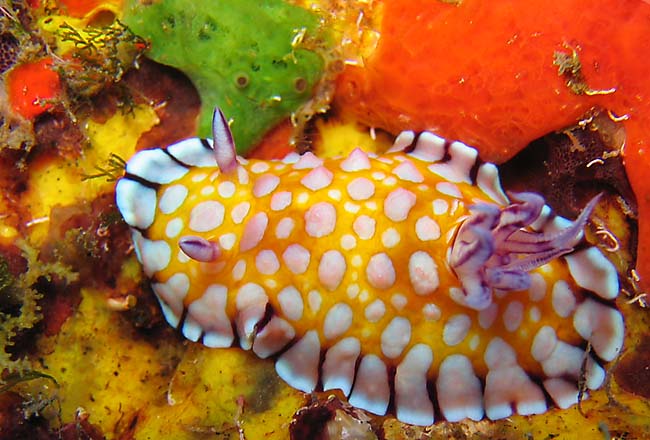This species has been observed on Reunion Island
Species characteristics : This sea slug is easely distinguished by the magnificent, marginal bright blue (white in our specimens) blocks of color which appear in series separated by black area of pigment. |

|
|
| Showing species characteristics... | Photo Sophie Darnis Reunion, "Tour de Boucan" at St Paul, 17 m, 8 July 2006, size 35 mm |
|
Remarks :
Identification confirmed by Bill Rudman
Synonymous : (according Worms)
- Chromodoris roboi, Gosliner & Behrens, 1998
Bibliographic data :
There is a bit of colour variation in the sea slug, and there are two forms : a streaked and a spotted colour form ( see Bill Rudman sea slug site). The 6 specimens we have found are spotted form as shown on our photo.
As G.conchyliatus it raises and lowers its anterior end when actively crawling.
The marginal bright blue (white in our specimens) of color are squarish or rectangular in shape with edges that are rounded of varying degree. The black color sometimes extends into the outer edges of the blue area, bisecting them to varying degree. The blue coloration often extends inward from the black marginal band interrupting the yellow-orange pigment which covers most of the notum of the animal.
In some specimens dark brown blotches cover the dorsal surface to varying degree. These areas appear wine-colored or black depending on the amount of pigment present.
If you find this colour form or an other one in Reunion Island, please Contact us ...
Holotype : From Okinawa, in Gosliner and Behrens. Photo Robert Bolland
This sea slug is very similar to Goniobranchus vibratusbut G. vibratus differs by its vibrating gills which rhythmically wave much like species of Thorunna, its yellow-orange notum with white pustules and a white marginal region with triangular dark blue interrupting the white and its very restricted distribution, known only in Hawaii and tropical north Pacific...
References :
Bill Rudman Sea slug site : Sea Slug Forum : Chromodoris roboi
Nudipixel Chromodoris roboi
Publications :
Johnson R.F. & Gosliner T.M. (2012) Traditional taxonomic groupings mask evolutionary history: A molecular phylogeny and new classification of the chromodorid nudibranchs. PLoS ONE 7(4): e33479
Gosliner, T.M. & Behrens, D.W. (1998) Five new species of Chromodoris (Mollusca: Nudibranchia: Chromodorididae) from the tropical Indo-Pacific Ocean. Proceedings of the California Academy of Sciences 50(5): 139-165
Other photos of Goniobranchus roboi :
Sophie Darnis "Tour de Boucan" at St Paul, 17 m, 8 July 2006, size 35 mm 1 : The black color sometimes extends into the outer edges of the blue ( or white) area, bisecting them to varying degree. 2 : The blue (or white) coloration often extends inward from the black marginal band interrupting the yellow-orange pigment which covers most of the notum of the animal. 3 : Dorsal patches are different sizes and shapes and the largest of which are raised on low pustules. 4 : The rhinophores are creamish with a purple streak up both anterior and posterior axes. |
 |
 |
Sophie Darnis "La Barge" at St Paul, 26 m, 3 February 2007, size : 30-35 mm. A very colored photo of this seaslug crawling on a anchor's wreck. |
Maurice Jay May be a juvenile form ? |
 |
More photos from Indian Ocean
Reunion, Goniobranchus roboi, by Maurice Jay
Reunion, Goniobranchus roboi, at Sainte Rose, by Sophie Albanhac
